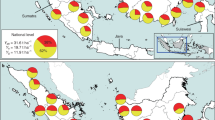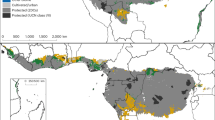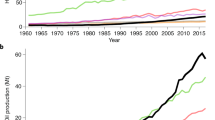Abstract
India is the world’s largest consumer and importer of palm oil. In an aggressive push towards self-sufficiency in vegetable oils, the Indian government is prioritizing the rapid expansion of domestic oil palm plantations to meet an expected doubling in palm oil consumption in the next 15 years. Yet the current expansion of oil palm in India is occurring at the expense of biodiversity-rich landscapes. Using a spatially explicit model, we show that at the national scale India appears to have viable options to satisfy its projected national demand for palm oil without compromising either its biodiversity or its food security. At finer spatial scales, India’s oil palm expansion needs to incorporate region-specific contingencies and account for trade-offs between biodiversity conservation, climate change, agricultural inputs and economic and social security. The policy decisions that India takes with respect to oil palm can substantially reduce future pressures to convert forests to oil palm plantations in the tropics globally.
This is a preview of subscription content, access via your institution
Access options
Access Nature and 54 other Nature Portfolio journals
Get Nature+, our best-value online-access subscription
$29.99 / 30 days
cancel any time
Subscribe to this journal
Receive 12 digital issues and online access to articles
$119.00 per year
only $9.92 per issue
Buy this article
- Purchase on Springer Link
- Instant access to full article PDF
Prices may be subject to local taxes which are calculated during checkout



Similar content being viewed by others
Data availability
Source data on spatially explicit oil palm yields under various scenarios are freely available at https://gaez.fao.org/pages/data-viewer. Source data on land use and land cover are freely downloadable at https://land.copernicus.eu/global/products/lc. Vector and raster data files used in the analyses in this manuscript are available at https://doi.org/10.5061/dryad.fj6q573v3.
Code availability
The R script used in the analyses in this manuscript is available at https://doi.org/10.5061/dryad.fj6q573v3.
References
Vijay, V., Pimm, S. L., Jenkins, C. N. & Smith, S. J. The impacts of oil palm on recent deforestation and biodiversity loss. PLoS One 11, pe0159668 (2016).
Rulli, M. C. et al. Interdependencies and telecoupling of oil palm expansion at the expense of Indonesian rainforest. Renew. Sustain. Energy Rev. 105, 499–512 (2019).
Davis, K. F. et al. Tropical forest loss enhanced by large-scale land acquisitions. Nat. Geosci. 13, 482–488 (2020).
Strona, G. et al. Small room for compromise between oil palm cultivation and primate conservation in Africa. Proc. Natl Acad. Sci. USA 115, 8811–8816 (2018).
United States Department of Agriculture, Foreign Agricultural Service. Data retrieved from: https://apps.fas.usda.gov/psdonline/app/index.html#/app/advQuery (2020).
Sagar, H. S. et al. India in the oil palm era: describing India’s dependence on palm oil, recommendations for sustainable production, and opportunities to become an influential consumer. Trop. Conserv. Sci. 12, 1940082919838918 (2019).
Jadhav, R. Exclusive: India urges boycott of Malaysian palm oil after diplomatic row—sources. Reuters (13 January 2020).
Srinivasan, U. Oil palm should not be expanded in Arunachal Pradesh. Arunachal Times (October 2016).
Ministry of Agriculture and Farmers’ Welfare. National Mission on Oilseeds and Oil Palm; https://nmoop.gov.in (Government of India, 2020).
Bose, P. Oil palm plantations vs shifting cultivation for indigenous peoples: analyzing Mizoram’s New Land Use Policy. Land Use Policy 81, 115–123 (2019).
Dhar, A. Enter oil palm in northeast India: centre, Patanjali, Godrej bet big. The Citizen (16 September 2020).
Raman, T. R. S. R. Is oil palm expansion good for Mizoram? The Frontier Despatch 3, 6–7 (2016).
Khandekar, N. Expanding oil palm plantations in the northeast could extract a long-term cost. The Wire (4 August 2020).
Mandal, J. & Raman, T. R. S. R. Shifting agriculture supports more tropical forest birds than oil palm or teak plantations in Mizoram, northeast India. The Condor 118, 345–359 (2016).
Nandi, J. Oil palm push on the northeast may impact biodiversity, water table, say experts. Hindustan Times 10, 51 (2020).
Myers, N., Mittermeier, R. A., Mittermeier, C. G., Da Fonseca, G. A. B. & Kent, J. Biodiversity hotspots for conservation priorities. Nature 403, 853–858 (2000).
Global Agro-Ecological Zones, GAEZ v.3.0 (Food and Agriculture Organization, 2016); https://gaez.fao.org/pages/data-viewer
Corley, R. H. V. How much palm oil do we need? Environ. Sci. Policy 12, 134–139 (2009).
Meijaard, E. et al. The environmental impacts of palm oil in context. Nat. Plants 6, 1418–1426 (2020).
West, P. C. et al. Leverage points for improving global food security and the environment. Science 18, 325–328 (2014).
Fan, Y., Li, H. & Miguez-Macho, G. Global patterns of groundwater table depth. Science 339, 940–943 (2013).
Shaktivadivel, R. The Agricultural Groundwater Revolution: Opportunities and Threats to Development (CAB International, 2007).
Lee, J. S. H., Miteva, D. A., Carlson, K. M., Heilmayr, R. & Saif, O. Does oil palm certification create trade-offs between environment and development in Indonesia? Env. Res. Lett. 15, 124064 (2020).
Sankar, K. N. M. Oil palm finds favour with East Godavari farmers. The Hindu (25 January 2017).
Curry, G. N. & Koczberski, G. Finding common ground: relational concepts of land tenure and economy in the oil palm frontier of Papua New Guinea. Geogr. J. 175, 98–111 (2009).
DeVos, R., Kohne, M. & Roth, D. We’ll turn your water in Coca Cola: the atomising practices of oil palm development in Indonesia. J. Agrar. Change 1, 385–405 (2018).
IPCC. Climate Change: Synthesis Report (eds Core Writing Team, Pachauri, R. K. & Meyer, L. A.) (IPCC, 2014).
IPCC. IPCC Special Reports on Emissions Scenarios: Summary for Policymakers (IPCC, 2000).
Schwalm, C. R., Glendon, S. & Duffy, P. B. RCP8. 5 tracks cumulative CO2 emissions. Proc. Natl Acad. Sci. USA 18, 19656–19657 (2020).
Copernicus Land Monitoring Service (European Environment Agency, 2020).
Hoffman, M., Koenig, K., Bunting, G., Cosntanza, J. & Willams, K. J. Biodiversity Hotspots v.2016.1 (2016); https://doi.org/10.5281/zenodo.3261806
IUCN World Database on Protected Areas, online April 2017 (UNEP-WCMC, 2016); www.protectedplanet.net
QGIS Development Team. QGIS Geographic Information System (Open Source Geospatial Foundation, 2021); http://qgis.osgeo.org
R Core Team. R: A Language and Environment for Statistical Computing (R Foundation for Statistical Computing, 2021).
Acknowledgements
We thank M.O. Anand and R. Senior for their help with the GIS analyses. A.T. Vanak commented on savannah/grassland areas and grassland biodiversity in India. This work was supported by a grant from the High Meadows Foundation. K.F.D. was supported by The Nature Conservancy’s NatureNet Science Fellows programme. J.S.H.L. acknowledges funding from the Singaporean Ministry of Education Academic Research Fund Tier 1 RG145/19.
Author information
Authors and Affiliations
Contributions
U.S., N.V. and D.S.W. co-conceived the paper. U.S., N.V., J.S.H.L., D.D.C. and K.F.D. extracted the data from online sources and performed the analysis. U.S. wrote the first draft of the manuscript and all authors contributed substantially to revisions.
Corresponding author
Ethics declarations
Competing interests
The authors declare no competing interests.
Additional information
Peer review information Nature Food thanks Clinton Jenkins, Edward Mitchard, Stuart Pimm and Giovanni Strona for their contribution to the peer review of this work.
Publisher’s note Springer Nature remains neutral with regard to jurisdictional claims in published maps and institutional affiliations.
Supplementary information
Supplementary Information
Supplementary methods, Tables 1–3 and Figs. 1–3.
Rights and permissions
About this article
Cite this article
Srinivasan, U., Velho, N., Lee, J.S.H. et al. Oil palm cultivation can be expanded while sparing biodiversity in India. Nat Food 2, 442–447 (2021). https://doi.org/10.1038/s43016-021-00305-w
Received:
Accepted:
Published:
Issue Date:
DOI: https://doi.org/10.1038/s43016-021-00305-w
This article is cited by
-
Prioritizing India’s landscapes for biodiversity, ecosystem services and human well-being
Nature Sustainability (2023)
-
De-oiled palm kernel cake for stall-fed buffaloes: effect on milk constituents, nutrient digestibility, biochemical parameters, and rumen fermentation
Tropical Animal Health and Production (2022)
-
India’s path to sustainable oil palm production
Nature Food (2021)



